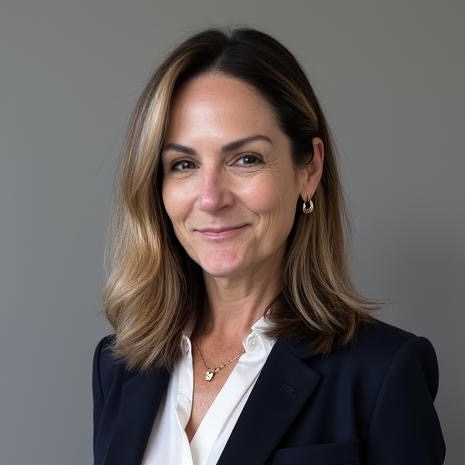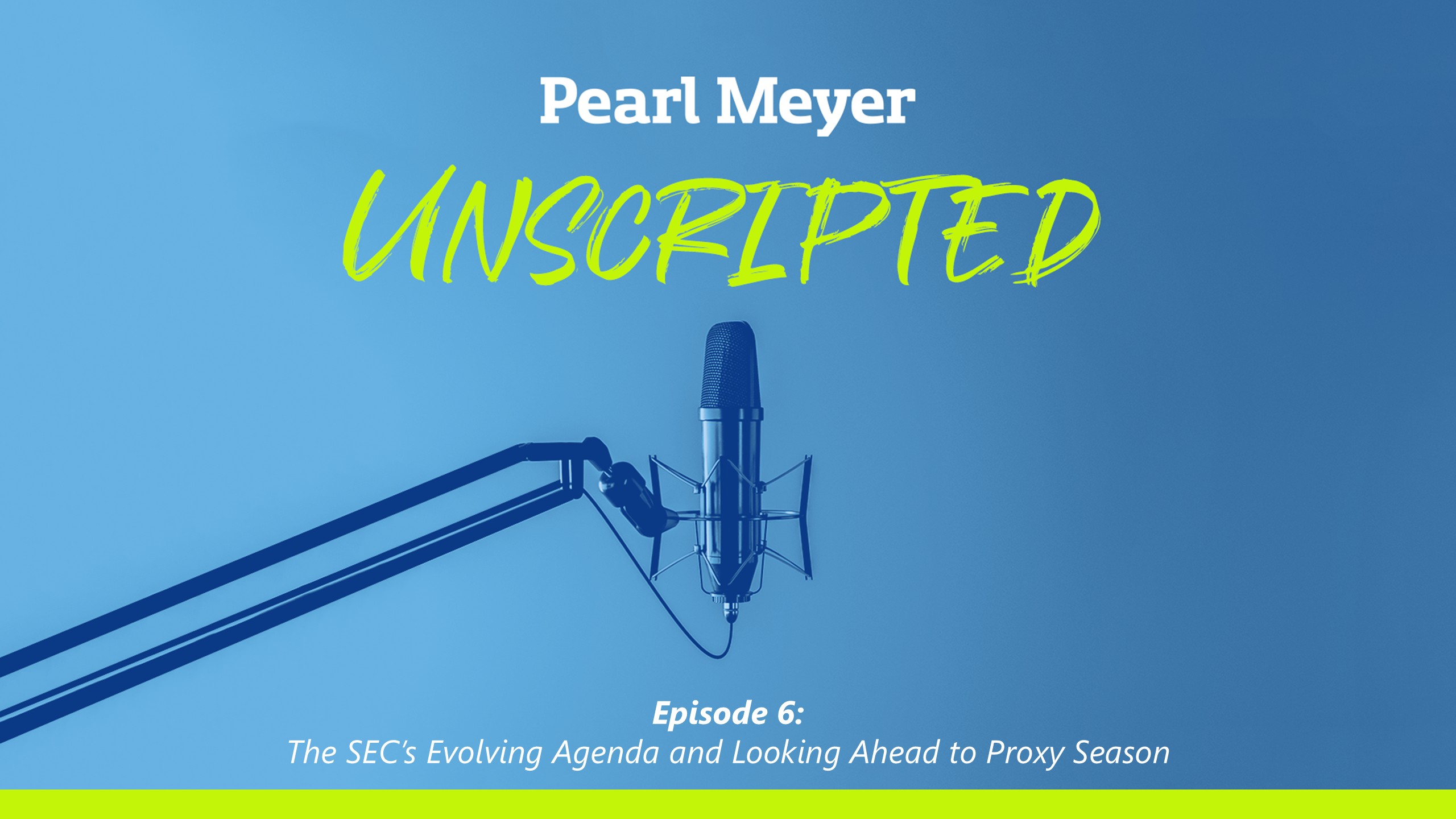
Podcast | Oct 2025 | The Pearl Meyer Unscripted Podcast
The SEC’s Evolving Agenda and Looking Ahead to Proxy Season
S2 Ep6: The SEC is revisiting its rules around disclosure for the first time in nearly two decades.
Transcript
Jake: Are we about to enter a new era with respect to executive compensation disclosure? The SEC is revisiting its rules around disclosure for the first time in nearly two decades and has already received more than a thousand public comments. What regulations might be changing and when? And how should boards be preparing for potential changes and communicating to their investors?
In this season two finale of Pearl Meyer Unscripted, Mark Rosen and Aalap Shah call upon Deb Lifshey and Sharon Podstupka to read the tea leaves on what might be changing and what compensation committees can be doing right now to prepare. Let's listen in...
Mark: Hey Aalap, hope you're doing well. We've been talking this season about a number of compensation issues related to business environment. But you know, the one thing we haven't talked much about was the regulatory environment. And you know, this current isn't new anymore. Perhaps we should get a briefing on what's going on.
Aalap: What a great idea, Mark. I think that would really be on point. But I think we should also talk about how companies are explaining all those decisions that we made and talked about to shareholders.
Mark: Well, what do know, we've got Deb Lifshey and Sharon Podstupka who leads our Technical Advisory Group and this is what they do. Can you brief us? Welcome Deb and Sharon.
Deb: Thank you.
Sharon: Yeah, thanks for having us.
Deb: This is a really exciting time in the disclosure landscape because for the first time in almost two decades, the SEC is taking a pause and revisiting all of the rules that we got back in 2006 which were quite extensive and have grown over time. And I think investors and companies and issuers and everybody's becoming more and more aware that disclosures are becoming longer, they're becoming more complex, and they don't necessarily provide a whole lot of incremental benefit to those investing and making decisions based on disclosures. So, it's exciting because this is happening in real time.
As many of you know, the SEC had a meeting, an open forum, in the end of June and they invited public comment. The public comment period is still open. They've had over a thousand comments on all facets of item 402, which govern executive compensation disclosure. At this point, are certain that these rules will not take effect for this coming proxy season the best anticipated time scenario is proposed rules are released towards the end of the year. There's usually a comment period. Final rules will be issued, if they are, early '26 and then it'll be a transition period. So it will be for the following proxy just in case any of you are panicking that you have to do any amendments or get geared up for a totally new landscape. That's not the case, at least for the next year.
Aalap: So I get it, Deb, it's in process. But can you give us an indication of some of the really hot buttons or likely targets for change? Because I think that would be really useful.
Deb: Right. I mean, as an overall item that is under review is again the length and the clarity and the materiality. We get the sense for the SEC that they really want to reduce the filings. They want to look at an in-depth level, all the tables, are they necessary? Are they providing valuable information? And the backdrop is, of course, some of the regulations are required by legislation. So, we what is required under Dodd-Frank. And then we have items that the SEC has drafted in its discretion or in its interpretation of Dodd-Frank rules. So, they have some boundaries about what they can hit.
But the one that seems to really come up as the biggest hot topic given recent events is disclosure of perquisites. And in that, what kind of disclosures are required with respect to security detail. There have been several suggestions that the SEC is seriously considering. Maybe it will exclude security of executives as part of the perq. disclosure. Maybe there will be a higher threshold. Currently we have a threshold from 20 years ago which was $10,000.
So if you're going to provide perquisites, oftentimes companies just exceed that organically at this juncture. You know, the SEC might be taking a closer look at maybe parsing out use of the corporate airline That was a real hot topic 20 years ago but it's not so much anymore. And I think the SEC also realizes that perhaps this should be something that is dealt with in taxation rather than disclosures. So, perquisites are definitely an item they'll be taking a look at and how to sort of navigate what's happening in real life with respect to protection of executives and the necessity of reporting that.
I think the second thing that's providing corporations a lot of angst when they're reporting are the pay for performance tables which if you've been in it, even though every year you know you're sort of doing the same thing, it takes a lot of effort and so they're looking at different ways that perhaps they could stay within the confines of what is required under Dodd-Frank but still provide the guidance that is needed. Some things that have been batted around are reduction of the number of NEOs that are reported, maybe reduce the number of years of reporting, or maybe scale back on what is required for performance relationships.
Couple other things I just want to throw out there that they're talking about, investors aren't complaining about too much, nor are issuers of the CEO pay ratio. You know, it was like a big deal when it first came out, how to get to the median and reporting and whether or not anyone would care. And it seems to sort of take a back burner to all of the other things that are on the hot plate at this point.
The other item that they might be looking at, they might be revisiting how clawbacks are required and the level of detail. You know, a lot of it was easy when it first went into place. A lot of investors already had clawback and policies, but now that we're getting into actually implementing the clawbacks, the nuances and difficulties of that are surfacing. So again, the SEC might be taking a look at how they can amend that within the confines of what is required under Dodd-Frank. So those are the highlights.
Aalap: Sharon, from your perspective, anything that you think is important to be considering when you think about disclosure?
Sharon: There's always important things to consider when you're getting ready to craft your executive compensation disclosure. I think the key point here listening to Deb is that nothing really is going to change heading into this year's proxy season. So, your 2026 proxy statement with your CD&A that describes your 2025 executive compensation program won't change all that much, but that doesn't mean you shouldn't be thinking about it now.
Mark: Well, wait a minute, none of my clients are necessarily in the penalty box. They got good programs, who got good say-on-pay last year. I mean, why would we start now?
Sharon: Because time is a tickin, Mark. And I think that the narratives are becoming increasingly important and the clarity in those narratives and the themes that are important to companies, whether it be business situations or leadership transitions or special awards or any of those complicated or complex decisions that have been made throughout the year need to be explained in a transparent way. There's expectations that they are defensible and writing that narrative just takes time. And I think that oftentimes there's a disconnect between, you know, the committee's expectations on what those messages should be and perhaps management's expectations or even those third parties who might be drafting. So, getting everyone on the same page now is a really important step.
Mark: Well, I guess it would be good to not have to cram everything into that first quarter when we're already busy working on changes for 2026. What would a best practice timeline look like?
Sharon: So, of course, there's no one-size-fits-all. I think we all know that. Companies have their own calendars, their own committee rhythms, sensitivities around sharing information. But I think that best practice shows that the strongest narratives come from this disciplined process that start in the early fall. Now is the time to be figuring out who's doing what. Who is holding the pen, is it HR, is it legal, is it IR? Who is looking at last year's CD&A to determine what really needs to change? This isn't an exercise anymore where you can just roll forward dates and numbers. That just doesn't work. I think there are things companies need to think about whether or not they're in the penalty box about investor expectations. Has there been any investor feedback that would be important to this story?
Do you have any issues with the proxy advisors, even if you're not in the penalty box? So, if you can get all that information organized now, November and December can really get some heavy lifting done and write some narratives so come first quarter, there's a strong draft that committees can start to vet. There are also things now too that are known. So there's no reason to wait, right? 2025 decisions around base salary increases, peer group decisions, target incentives, all of that's already been decided and approved for the most part. So there really is no reason to wait.
Aalap: That sounds really reasonable, Sharon. I think the tendency that people have is that the proxy is something that we work on in the next year, once the year closes, but I think you're absolutely right. I mean, a lot of those decisions have been made, or at least you have some indication. So nothing wrong with sort of starting a document so you can get the words in perfect order and have all those review meetings without any tension or stress.
Sharon: Yeah, the one other thing I'll add is that, you know, and these are for calendar year filers, right? We're talking about a best practice calendar year kind of rollout, is that when you have all of this work done at the end of the calendar year, it really does give you the first quarter to deal with fire drills. And we know that there are fire drills. And we know that there are decisions that are made that maybe have been changed or the expectation was something's going to happen and we had to course correct on an award or something. So making sure that you can be flexible and nimble at the 11th hour is really important.
Deb: And if I could jump in here just to emphasize, you know, with these changes that are happening, whether they're large scale changes or small tweaks, it's the narrative this year is even more critical because this will need to be a narrative that carries through to next year. In the event that the SEC says no more tables or no more tables that are required under Dodd-Frank and you don't have all of these numbers that you have to fill in the blanks, you have to be thinking this year about what is the story you want your investors to understand? And will it be consistent next year? Because if investors are relying more heavily on narratives next year, your narrative is extremely important this year.
Mark: Hey, so Sharon, one of the things that we did a few years ago that I think has gotten a little out of hand is to create an executive summary. And some of these executive summaries are pages long. You almost need an executive summary to the executive summary. But I know that you've cleaned those up some and to emphasize some of the key points, you've actually even put in a letter or a message from the chair of the committee. How is that working?
Sharon: It works really well. It works really well for companies who are in unique situations for the most part, too. I think what gets lost oftentimes in these CD&A narratives is the board's voice. And investors want to hear from the comp committee. We know that regardless of say on pay result, there needs to be a point of view and a perspective from the compensation committee, from the board demonstrating that the executive compensation program is sound, it's aligned with strategy, it's meant to attract, retain, motivate all of the things we love to say. But those questions and answers and insights or letters, whatever approach you choose to use have become very meaningful and investors really appreciate it.
Aalap: Yeah, I mean, in talking with some investors, I I think what it really does, not to sound corny, it does create a more of a personal relationship between the management team and the shareholder base when you're doing that. Because, you know, ultimately what the investors are trying to do is trying to understand your business, understand your challenges, and then assess your compensation program, you know, through that lens. So I welcome reading those letters, and I think more and more companies should do it.
Sharon: The cautionary note here is that it can't necessarily be an add-on, right? That's been a historic challenge with, I think, the drafting process. There's a tendency to just add and add and add, and you get these layers of historic references, and you really have to challenge yourself in the drafting process to say, 'we said this five years ago. We've said it for the last five years. This is an example. Do we need to say it this way again? Is it important to investors?' And so, when I'm helping my clients draft these narratives, I challenge them on those things. And is this important to your story this year? How much historic information do we really need to provide in order to put forward a context that's going to resonate with the stakeholders, whether it be investors proxy advisors? So, there's a lot of work in thinking and careful thought that needs to go behind this drafting process. So, I'll bring it back to the beginning, Mark. That's why you should have started last month.
Aalap: So true. Hopefully Mark will listen, but I'm convinced. So thank you for that, Sharon.
Deb, can I just pick your brain on another question? I think I'm getting a little confused about the interplay between disclosure and the new rules around 10D and 10G.
Deb: Right and it's a perfect segue because really, you know, talking about really communicating in writing is so critical this year because what we're seeing is as a result of the rules that I will explain, is a little bit of a trend towards reluctance to engage so much for some of the index funds that have substantial holdings. So in short, there's two schedules that are required by the SEC. One is a 13D. So, under 13 D, if an investor or group of investors buys more than 5% of a company stock they have to tell the world about it and it's not just the formality it's very detailed you've got a list who you are, how much you own, where the money came from, essentially. Then there's a simpler option it's schedule 13G and that's meant really for institutional investors like mutual funds and index funds those are investors who cross that same 5% line but they're not trying to steer the company. It's a shorter, simpler form and it assumes you're a passive investor and not an activist. Well, in 2025, along with the rest of the shifts that we're seeing, the SEC issued new guidance that tightens the definition of 'passive.'
So that means that big index funds such as the top three, Vanguard, BlackRock and State Street, might no longer qualify for the easy 13G if their engagement with companies is seen as quote 'influencing the outcome.' So, for example, if a fund says 'in a meeting with management we'll support your board only if you change your compensation plan or adopt certain ESG targets' that could now be considered an activist behavior which would then trigger a larger 13D filing, which most investors want to avoid. And so what we're seeing and what we're told is the impact is that to avoid triggering 13D obligations, investors are coming to meetings with management and they're being rather passive because they don't want to appear to be actively influencing. And that means that management and their consultants and whoever is meeting with these investors have to be a little bit more active in telling them about programs, setting the agenda, outlining their long-term vision, asking them if they have any questions because they might in fact be a little bit more passive at these meetings to avoid the longer disclosures. So, you know, coming full circle to the narratives and what we put out in writing, it's so important because it is possible that some of these meetings will be a little bit more reserved in light of these different filing requirements.
Aalap: Thanks for that, Deb. I mean, that does clear things up for me, but I'm sure I'm going to have some more questions.
Mark: You know, we could go on for a long time for all of these topics.
Aalap: Yeah, absolutely. But you know, I got to run and start writing some CD&A's, but I'm glad we have Sharon and Deb on the team to help us. Cause some of this stuff is fast moving and a little bit confusing. So, thank you both.
Mark: Yeah, and I probably need to get started on CD&As too. Sharon and Deb, this has been great. Appreciate your time.
Deb: Thank you.
Aalap: Thanks.
Mark: We'll see you next time. Thanks Aalap.
Aalap: Bye, Mark.
Jake: Well, that wraps up the second season of the Pearl Meyer Unscripted podcast. While you ensure you are making progress on your CD&A, we'll keep an eye on the regulatory landscape and may be back in your feed with special episodes as events warrant. We'll also return soon with another full season of Unscripted discussion and debate, intended as always to help organizations build, develop, and reward great leadership teams that drive long-term success. Thanks for listening.
Look for new episodes each Monday afternoon at Pearl Meyer Unscripted, subscribe to our YouTube Channel, and listen on Spotify.




